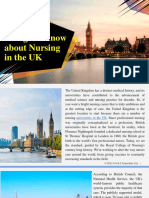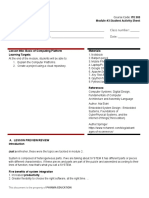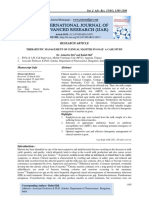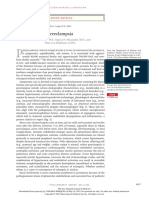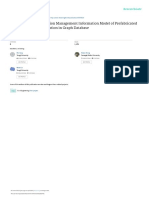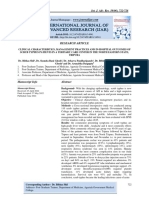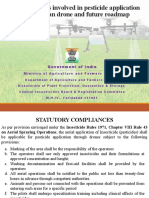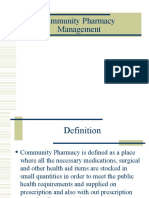Professional Documents
Culture Documents
Cross-Sectional Study On Knowledge, Attitude and Practice of Pharmacist at Community Pharmacy in Indonesia About COVID-19
Original Title
Copyright
Available Formats
Share this document
Did you find this document useful?
Is this content inappropriate?
Report this DocumentCopyright:
Available Formats
Cross-Sectional Study On Knowledge, Attitude and Practice of Pharmacist at Community Pharmacy in Indonesia About COVID-19
Copyright:
Available Formats
Volume 7, Issue 5, May – 2022 International Journal of Innovative Science and Research Technology
ISSN No:-2456-2165
Cross-Sectional Study on Knowledge, Attitude and
Practice of Pharmacist at Community Pharmacy in
Indonesia about COVID-19
Yelly Oktavia Sari, Dedy Almasdy, Dini Rizki Amalia
Faculty of Pharmacy, Andalas University Padang,
West Sumatera, Indonesia
Abstract:- COVID-19, which first occurred in Wuhan, Pharmacists are an important part of the healthcare
China, has spread rapidly to almost all countries including system, and their role is critical in perfecting the COVID-19
Indonesia and was announced by the WHO as a pandemic. outbreak management cycle (6). Pharmacists at community
The Indonesian government establishes a “Task Force pharmacy provide patient-oriented pharmaceutical care and
Acceleration of Handling COVID-19” for handling practice in drug stores (7). Patient-oriented pharmaceutical
COVID-19. Pharmacists are an important part of the care in community pharmacy during the COVID-19 period
health care system and play a role in perfecting the must pay attention to the sanitation of dispensing room and
COVID-19 outbreak management cycle. Pharmacists play personal protection of personnel in customer service, and it is
a role in ensuring the continued functioning of the health necessary to provide education on preventing COVID-19
care system in the detection, prevention and management transmission to customers(8).
of cases. In this practice, pharmacists need knowledge,
attitudes and practices related to COVID-19. This study In their practice, pharmacists in community pharmacy
aims to evaluate knowledge, attitudes and practices of have very big possibilities for contracting this pandemic. As
pharmacists in Community Pharmacy in Indonesia about pharmacists in community pharmacy have direct contact with
COVID-19, and examines the relationship between these patients during this crisis, understanding their knowledge,
three variables. This research is a cross-sectional study, attitudes and practices towards COVID-19 is important to
and the sampling technique is purposive sampling. The classifying misconceptions about COVID-19 treatment and to
study instrument was a validated questionnaire that was contribute of COVID-19 screening.
distributed through social media (WhatsApp).
178pharmacist was qualified to participate in this study. This research to evaluated of the level of knowledge,
The results of the study showed that pharmacists have a attitude and practice of pharmacist at community pharmacy in
high level of knowledge (83.1%), positive attitude (54.5%) Indonesia about COVID-19.
and good practices (57.3%) about COVID-19. In this II. RESEARCH METHOD
study, knowledge level of pharmacists was influenced by
the education level, attitudes was influenced by the This research is an observational study with a cross-
education level and the province’s recovery rate, while sectional study design. This research was conducted on
practice was influenced by gender. Statistical analysis pharmacists who served in drug stores/ community pharmacy
between knowledge, attitude and practice of pharmacists spread across several provinces in Indonesia during the past
about COVID-19 showed that there was a significant few months (± 6 months) in December 2020 to May 2021.
relationship between knowledge with attitude and attitude The instrument used in this study was a questionnaire
with practice and knowledge with practice (p<0.05). designed on Google forms platform®. The questionnaire was
developed largely based on the World Health Organization
Keywords:- COVID-19, Knowledge, Attitude, Practice, (WHO) Questions and Answers on COVID-19 and from
Community Pharmacy. several existing research that was adapted to the
I. INTRODUCTION pharmaceutical study. Respondents in this study were selected
by purposive sampling method according to the inclusion
The mysterious pneumonia cases that was first reported criteria and exclusion criteria set by the researcher. The
in Wuhan, China's Hubei Province in December 2019 has content validity test was carried out by experts, namely five
spread widely to various other provinces in China and several pharmacists and one linguist. The validity and reliability
other countries in a short time (1). This virus is named SARS- testing was then carried out on 30 people according to the
COV-2 and the disease caused by this virus is named COVID- general rules of research in order to obtain a distribution of
19 (2). On March 11, 2020, WHO declared COVID-19 a research results that approached the normal curve (9).
pandemic (3). The first case in Indonesia was detected and
announced on March 2, 2020 by President Jokowi (4). The The data collection method was carried out by
number of incidents in Indonesia continues to increase with a distributing online questionnaires through social media
morbidity rate of 8.7% which is the highest rate in Southeast (WhatsApp) by providing a link that was connected to the
Asia and much higher than China (4%) (5). questionnaire to be filled out by the respondents. The
questionnaire contains 47 questions including: socio-
demographic data (10 questions), knowledge level evaluation
(17 questions), attitude (8 questions) and practice (12
IJISRT22MAY766 www.ijisrt.com 691
Volume 7, Issue 5, May – 2022 International Journal of Innovative Science and Research Technology
ISSN No:-2456-2165
questions) in pharmaceutical care and practices about COVID- the most age in the range <35 years as many as 93 respondents
19. After the data collected, then its tabulated and coded. The (52.2%) who are married as many as 146 respondents (82.0%)
data then processed using the SPSS program version 16. The with education level an average of 154 are a pharmacists
relationship of respondents' demographic characteristics with (86.5%) and experienced as a pharmacist ≤ 10 years as many
the knowledge level, attitudes and practices was determined as 117 respondents (65.7%) who generally work in provinces
using Chi Square. While Spearman’s correlation is used to with a moderate recovery rate of COVID-19 as many as 129
determine the relationship between these three variable that is respondents (72.5%).
relationship knowledge with attitude, attitude with practice
and knowledge with practice of pharmacist in Community Most of the respondents obtained information about
Pharmacy about COVID-19. COVID-19 from social media (36.2%) and television (31.3%).
Pharmacists need to have the right information about COVID-
III. RESULT AND DISCUSSION 19 and convey that knowledge to the public. The use of
accurate information media tools is one of the basic
The respondents who met the inclusion criteria was 178 requirements to prevent and control the spread of disease (10).
respondents. From the socio-demographic data, respondents The type of information most needed by respondents was
were categorized by gender, age, education level, marital about infection prevention and control (36.5%). This supports
status, experience and the division of provinces based on the the research results that the level of pharmacist participation in
recovery rate. Based on the results listed in table 1, out of 178 offline or online training is very low.
respondents it is known that most of the respondents are
female pharmacists as many as 127 respondents (71.3%) with
n = 178
No Characteristics of Respondents
F %
1 Gender
Man 51 28.7
Woman 127 71.3
2 Age
< 35 years old 93 52.2
≥ 35 years old 85 47.8
3 Marital status
Not Married 32 18.0
Married 146 82.0
4 Education level
Pharmacist 154 86.5
Pharmacist with additional education(master/doctor) 24 13.5
5 Experience
≤10 years 117 65.7
> 10 years 61 34.3
6 Provincial Division
Province with high recovery rate 29 16.3
Province with moderate recovery rate 129 72.5
Provinces with low recovery rate 20 11.2
7 Resources
Television 142 31.3
Social media 164 36.2
Health workers 71 15.7
Scientific journals 63 13.9
Other 13 2.9
8 More information needed
Pathology 86 19.4
Infection Prevention and Control 162 36.5
Diagnosis 57 12.8
Treatment 131 29.5
Other 8 1.8
Table 1: Distribution of pharmacists' socio-demographic characteristics in community pharmacy in Indonesia
The results of data collection using a questionnaire about the level of knowledge of pharmacists at Community Pharmacy in
Indonesia about COVID-19 can be seen in table 2.
IJISRT22MAY766 www.ijisrt.com 692
Volume 7, Issue 5, May – 2022 International Journal of Innovative Science and Research Technology
ISSN No:-2456-2165
Question True Frequency (%)
Fever, fatigue, convulsions and dry cough are the main symptoms of COVID- 54 (30.3)
19
The incubation period (from exposure to the first appearance of symptoms) of 75 (42.1)
COVID-19 is 2-5 days
The virus that causes COVID-19 can spread through respiratory droplets 83 (46.6)
when a patient coughs/sneezes even though they are more than two meters
away
There is no difference in the risk of potential exposure to pharmacists who 86 (48.3)
work in services with pharmacists who work in non-services.
The first case of COVID-19 was discovered in Hainan, China. 87 (48.9)
Azithromycin/levofloxacin given to COVID-19 patients to kill the SARS-2 87 (48.9)
corona virus
Mixing bleach and household cleaning to get the maximum disinfectant is the 90 (50.6)
right thing to do.
Individuals aged < 60 years and do not have health problems may use non- 113 (63.5)
medical masks
WHO prohibits the use of dexamethasone in non-severe COVID-19 patients, 145 (81.5)
unless the patient has received other therapy
Vitamin D in COVID-19 therapy is needed by people who are not exposed to 148 (83.1)
sunlight (isolation)
All patients who are positive for COVID-19 have symptoms 149 (83.7)
To reduce the transmission of COVID-19, disinfection of environmental
surfaces can use Na. Hypochlorite (eg: Bayclin) 0.1%. 153 (86.0)
Use chloroquine for COVID is not recommended because it can cause heart 153 (86.0)
rhythm disturbances
Always and regularly wash your hands with soap or Hand sanitizer can
reduce the spread of the COVID-19 virus. 166 (93.3)
Avoiding touching your eyes, nose and mouth when serving patients can
prevent COVID-19 infection. 166 (93.3)
COVID-19 is a disease caused by the SARS 2 Corona virus (SARS-CoV-2). 169 (95.0)
Using a mask or face shield and the presence of a glass barrier when serving
173 (97.2)
patients who redeem drugs can reduce the spread of COVID-19
Table 2: Distribution of respondents based on knowledge questions
From the question of the level of knowledge of found in Nigeria at 91%(11) and higher than that found in
pharmacists, 95% of respondents know that COVID-19 is a Ethiopia and Egypt by 68% and 66.7% (12),(10).
disease caused by Corona virus SARS 2 (SARS-CoV-2). From
the achievement of the highest score, it can be understood that The lowest achievement was found in questions
almost all respondents know how to protect themselves from regarding the main symptoms of COVID-19, namely
transmission of COVID-19, by using a mask or face shield fever,tired and dry cough that is, only 30.4% of respondents
and the presence of a glass barrier when serving patients who who answered correctly were different from those who
redeem drugs (97.2%), avoiding touching the eyes, nose and answered correctly Found by Cacodcar about 61% (13), and
mouth when serving patients (93.3%), Always and regularly by Alzoubi about 68.4% (14). According to WHO the most
washing hands with soap and hand sanitizer (93.3%) can common symptoms today are fever, fatigue, cough, and loss of
reduce the spread of COVID-19. This is similar with that the ability to feel or smell (anosmia).
IJISRT22MAY766 www.ijisrt.com 693
Volume 7, Issue 5, May – 2022 International Journal of Innovative Science and Research Technology
ISSN No:-2456-2165
Question f(%)
Strongly
disagree 0 (0)
Do not agree 1 (0.6)
Neutral 8 (4.5)
I am willing to explain to patients how to prepare disinfectant Agree 98 (55.0)
at home Strongly agree 71 (39.9)
Strongly
disagree 1 (0.6)
Do not agree 9 (5.0)
Neutral 30 (16.9)
I am willing to provide pharmaceutical services for patients Agree 65 (36.5)
with COVID-19 infection with complete PPE Strongly agree 73 (41.0)
Strongly
disagree 0 (0)
Do not agree 0 (0)
I feel uncomfortable when patients wait for drugs at the Neutral 19 (10.7)
Pharmacy/Pharmaceutical Installation without keeping a Agree 69 (38.8)
distance. Strongly agree 90 (50.6)
I am worried that when I serve patients there is no glass Strongly
barrier between me and the patient disagree 0 (0)
Do not agree 1 (0.6)
Neutral 15 (8.4)
Agree 68 (30.2)
Strongly agree 94 (52.8)
I am afraid that while working in pharmaceutical facilities I Strongly
do not use PPE (masks, face shields or gloves). disagree 0 (0)
Do not agree 0 (0)
Neutral 14 (7.9)
Agree 70 (39.3)
Strongly agree 94 (52.8)
Strongly
disagree 0 (0)
Do not agree 0 (0)
I feel the need to ensure the availability of pharmaceutical Neutral 13 (7.3)
supplies needed for handling COVID-19 Agree 58 (32.6)
Strongly agree 107 (60.1)
I'm worried if the patient who redeems the drug to the Strongly
pharmacy/pharmacy installation doesn't wear a mask disagree 0 (0)
Do not agree 0 (0)
Neutral 3 (1.7)
Agree 59 (33.1)
Strongly agree 116 (65.2)
Strongly
disagree 0 (0)
Do not agree 1 (0.6)
Neutral 3 (1.7)
If I am exposed to COVID-19, I will isolate according to the Agree 54 (30.3)
COVID-19 handling guidelines Strongly agree 120 (67.4)
Table 3: Distribution of respondents based on attitude questions
IJISRT22MAY766 www.ijisrt.com 694
Volume 7, Issue 5, May – 2022 International Journal of Innovative Science and Research Technology
ISSN No:-2456-2165
Judging from the level of achievement of the respondents respondents believed that using a mask could reduce the
in each of their statements of attitude about COVID-19, it was spread of the virus(14).
found that respondents have positive attitude about COVID-
19, it was found in their statements that responded to worry While the lowest achievement of respondents' attitudes
when patients who redeemed drugs at the Community can be seen from their statements about their willingness to
Pharmacy/drug stores did not wear masks, that achievement of explain to patients about how to prepare disinfectants at home,
respondents' attitudes reached 65.2%. This is supported by where in this statement only 39.9% agreed. This is supported
research conducted by Zhang that 85% of health workers are by the level of knowledge of pharmacists who are still lacking
worried that they will be exposed to the COVID-19 virus in in how to prepare disinfectants at home and that mixing bleach
the workplace(15). In addition, in a study in Jordan, 68.4% of and household cleaning is wrong. This question was answered
correctly by only 50.6% of respondents.
Question f(%)
Did you participate in any training related to COVID-19 Always 35 (19.7)
during the pandemic (offline or online) Often 58 (32.6)
Seldom 54 (30.3)
Never 31 (17.4)
Are you educating the public regarding COVID-19. Always 49 (27.5)
Often 59 (33.1)
Seldom 57 (32.0)
Never 13 (7.3)
Do you limit the number of patients waiting for drugs at the Always 65 (36.5)
pharmacy/pharmacy?
Often 71 (39.9)
Seldom 30 16.9)
Never 12 (6.7)
Do you clean the surface area where the work area is with Always 91 (51.1)
disinfectant. Often 70 (39.3)
Seldom 16 (9.0)
Never 1 (0.6)
I remind patients who will enter the Pharmacy / Pharmacy Always 95 (53.4)
Installation to put on the correct mask
Often 60 (33.7)
Seldom 20 (11.2)
Never 3 (1.7)
Do you always keep your distance from people who come to Always 108 (60.7)
the pharmacy/pharmacy installation?
Often 62 (34.8)
Seldom 8 (4.5)
Never 0 (0)
Do you always use a mask, face shield or gloves at work? Always 117 (65.7)
Often 50 (28.1)
Seldom 10 (5.6)
Never 1 (0.6)
Do you wash your hands the right way? Always 119 (66.9)
Often 55 (30.9)
Seldom 4 (2,2)
Never 0 (0)
I make sure the hand washing facilities where I work are Always 120 (67.4)
functioning properly Often 47 (26.4)
Seldom 7 (3.9)
Never 4 (2,2)
Do you avoid touching your eyes, nose or mouth when Always 125 (70.2)
interacting with patients or customers? Often 46 (25.8)
Seldom 7 (3.9)
IJISRT22MAY766 www.ijisrt.com 695
Volume 7, Issue 5, May – 2022 International Journal of Innovative Science and Research Technology
ISSN No:-2456-2165
Never 0 (0)
After work, do you follow the health protocol when you get Always 128 (71.9)
home (shower and change clothes)
Often 41 (23.0)
Seldom 9 (5.1)
Never 0 (0)
Do you ensure the availability of masks at your Always 145 (81.5)
pharmacy/pharmacy installation Often 31 (17.4)
Seldom 2 (1,1)
Never 0 (0)
Table 4: Distribution of respondents by practice questions
Judging from the level of achievement of respondents in pandemic (offline or online), which in this statement only
each statement about their practices on COVID-19, it was reached 19.7%. Followed by the practice of pharmacists in
found regarding their practice efforts against COVID-19 well educating the public about COVID-19, which only reached
found in their statements that ensure the availability of masks 27.5%.
(81.5%), follow health protocols when they get home (71.9%)
and always avoid touching their eyes, mouth and nose when The role of health workers who serve the community is
interacting with people. other people, and always implement very important in preventing and the handling of COVID-19 at
health protocols when they get home from work (70.2%). This every level of intervention. Medical personnel are considered
is also supported by the high achievement rate in respondents' more capable of understanding the promotive and preventive
knowledge that in addition to avoiding touching the eyes, patterns of COVID-19 in the community. In fact, health
mouth and nose, the implementation of health protocols can workers who serve the community, including officers at
also reduce the spread of this virus. Almost the same as that pharmacies who are at the forefront of handling COVID-19,
obtained by Saqlain that pharmacists avoid touching the eyes, are the group most vulnerable to contracting the SARS-CoV-2
nose, and mouth by 74.6%(16). In contrast to research in Saudi corona virus.
Arabia which describes that 90.38% of respondents do not
avoid touching their eyes, mouth and nose because they are Table 5 shows that pharmacists with additional education
not related to the spread of the virus(17). Regarding the (master/doctor) have higher knowledge about COVID-19
implementation of the health protocol when coming home (p<0.05). This provides a significant relationship to the level
from work, Saefi found that only 60.38% of respondents of pharmacist knowledge about COVID-19. This is similar to
carried out the health protocol (changed clothes) when they that found in Pakistan and Bangladesh that the level of
came home from work before interacting with other family education is significantly related to the level of knowledge
members(18). Similar to what was found in Bangladesh that about COVID-19(21)(19).
98.6% of respondents always follow health protocols when The table also shows that the attitude of respondents in
they return home(19) dealing with COVID-19 was significantly higher (P<0.05) for
In carrying out their role as pharmacists who are pharmacists with additional education (master/doctor). The
responsible for pharmaceutical supplies, especially masks, province's recovery rate also had a significant effect on
81.5% of respondents carry out this role. From the research pharmacists attitude, it was seen that 70% had a negative
reported from Jordan that one of the reported roles of attitude in provinces with low recovery rates (P<0.05). This
pharmacists during a pandemic is ensuring adequate storage shows that the recovery rate of a region also affects the
and supply of drugs and medical devices in addition to the role attitude of pharmacists.
in disease prevention and infection control as well as a role in The practices of pharmacists on COVID-19, both in
patient care and support for other health professionals(20). carrying out pharmaceutical practices and in their roles as
This supports the achievement on the question of pharmacist pharmacists, shows that practice of female pharmacists have
practice who always ensures the availability of masks in good practices than men (P<0.05). Research conducted in
pharmacy/pharmacy facilities, which is 81.5%. Pakistan and Bangladesh, also found that female respondents
While the lowest achievement of respondents' practices have good practices in terms of preventing exposure to
can be seen from their statements about the lack of COVID-19 (that women are more likely to maintain a safe
participation in training related to COVID-19 during the distance than men).
IV. RELATIONSHIP BETWEEN VARIABLES
Variable Correlation Coefficient P Value
Knowledge – Practice 0.218 0.003*
Attitude – Practice 0.238 0.001*
Knowledge – Attitude 0.252 0.001*
Table 5: Correlation Score
IJISRT22MAY766 www.ijisrt.com 696
Volume 7, Issue 5, May – 2022 International Journal of Innovative Science and Research Technology
ISSN No:-2456-2165
Correlation between the knowledge level with attitudes, RESEARCH LIMITATIONS
attitudes with practices and knowledge level with practices, it
appears that there is a significant correlation between these Data on the number of pharmacists at Community
three variables. In theory it is said that behavioral change Pharmacy in Indonesia cannot be accessed, so to determine the
requires three stages, namely changing the knowledge level in number of samples only with the minimum number of samples
this case about COVID-19(cause, symptoms, how to treat, that must be met is determined. The number of samples is
how to transmit, how to prevent, how to maintain health and limited because this research data is only based on the number
how to live healthy and how to manage environmental health). of returned questionnaires due to limited communication with
After someone knows the stimulus or object, the next process pharmacists in the target provinces.
will assess or behave towards the stimulus or object which will
have an impact on the pharmacist's attitude about COVID-19 REFERENCES
(such as worrying about the causes, modes of transmission, [1.] Huang C, Wang Y, Li X, Ren L, Zhao J, Hu Y, et al.
methods of preventing disease, environmental health Clinical features of patients infected with 2019 novel
conditions and their effects on health) Finally, after someone coronavirus in Wuhan, China. Lancet.
knows the stimulus or object, then conducts an assessment or 2020;395(10223):497–506.
opinion on what is known, the next process is expected to [2.] Zhu N, Zhang D, Wang W, Li X, Yang B, Song J, et al.
carry out or practices what is they known or addressed it. A Novel Coronavirus from Patients with Pneumonia in
In this study, pharmacists had high knowledge (83.1%), China, 2019. N Engl J Med. 2020;382(8):727–33.
positive attitude (54.5%) and good practice (57.3%). In terms [3.] WHO. WHO Director-General’s opening remarks at the
of the effect of knowledge on attitudes and practices obtained media briefing on COVID-19 - 11 March 2020 [Internet].
in this study is the same as research conducted by Zhang in 2020 [cited 2020 Jul 20].
Henan, China (15). While the research conducted by Alzoubi Availablefrom:htttps://www.who.int/director-
in Jordan (14) shows no relationship between each variable. general/speeches/detail/who-director-general-s-opening-
remarks-at-the-media-briefing-on-covid-19---11-march-
This can be influenced by the massive amount of 2020
information regarding vigilance against COVID-19 because it [4.] MOORE PE. World Health Organization (WHO)
is already announced as a pandemic outbreak. In addition, the Indonesia Situation Report. Can Serv Med J.
incessant socialization of anticipatory movements to prevent 2020;11(3):121–6.
transmission. Information that is updated by the World Health [5.] Kemenkes-RI. COVID-19 [Internet]. Kemenkes. 2020.
Organization (WHO) and also by the Ministry of Health of the Available from: https://infeksiemerging.kemkes.go.id/
Republic of Indonesia on the number of exposure cases also [6.] Elbeddini A, Prabaharan T, Almasalkhi S, Tran C.
makes every individual, especially those at high risk, more Pharmacists and COVID-19. 2020;3:1–4.
careful. [7.] Menkes. Standar Pelayanan Kefarmasian di Apotek.
2016. Report No.: 73.
V. CONCLUSION [8.] Kemenkes-RI. Penanganan Pandemi Covid-19.
2020;19:32. Available from:
Pharmacists at Community Pharmacy have high https://covid19.go.id/storage/app/media/Protokol/Protoko
knowledge (83.1%), positive attitudes (54.5%) and good l Percepatan Penanganan Pandemi Corona Virus Disease
practices (57.3%). In the relationship of variables with socio- 2019.pdf
demography, there is a significant relationship (p<0.05) at the [9.] Sugiyono. Metode Penelitian Kuantitatif Kualitatif dan
education level to pharmacist’s knowledge about COVID-19, R&D. 20th ed. Bandung: Alfabeta; 2014.
there is a significant relationship (p<0.05) of education level [10.] Kara E, Demirkan K, Ünal S. Knowledge and attitudes
and the category of provincial recovery rate on pharmacist among hospital pharmacists about covid-19. Turkish J
attitudes against COVID-19 and there is a significant Pharm Sci. 2020;17(3):242–8.
relationship (p<0.05) in gender on pharmacists practices in [11.] Enenche F, Saleh A, Owoicho S, Abraham N, Jauro S,
dealing with COVID-19. From the relationship between Madukaji L, et al. Heliyon Knowledge , attitude , and
variables, there is a significant relationship between practice among healthcare workers towards COVID-19
knowledge level with practices, attitudes with practices and outbreak in Nigeria. Heliyon. 2020;6(November):e05557.
knowledge level with attitudes of pharmacists in dealing with [12.] Atkure Defar A, Molla G, Abdella S, Tessema M,
COVID-19 (p < 0.05). Ahmed M, Tadele A, et al. Knowledge, Practice and
associated factors towards the Prevention of COVID-19
ETHICSAPPROVAL among high-risk groups: A cross-sectional study in Addis
Ababa, Ethiopia. medRxiv. 2020;2020.08.14.20172429.
Ethics approval was obtained from the respective ethics
[13.] Cacodcar JA, Rataboli P V, Naik SS, Santos K Dos,
committees at the Medical Faculty of Andalas University in
Sanil M, Mardolker AA, et al. Assessment of knowledge
West Sumatra, Indonesia. All of the respondents invited to
, attitudes and practices regarding COVID-19 among
participate in this study gave informed consent before taking
pharmacists in Goa. 2020;7(12):5081–7.
part in this study. To protect the informant from any
[14.] Alzoubi HM, Alnawaiseh N, Al-mnayyis AM, Aqel A.
consequences, data were made anonymous (code) before
COVID-19 - Knowledge , Attitude and Practice among
analyses. The views and opinions of each informant were
Medical and Non-Medical University Students in.
considered equally.
2020;(April).
IJISRT22MAY766 www.ijisrt.com 697
Volume 7, Issue 5, May – 2022 International Journal of Innovative Science and Research Technology
ISSN No:-2456-2165
[15.] Zhang M, Zhou M, Tang F, Wang Y, Nie H, Zhang L, et
al. Knowledge, attitude, and practice regarding COVID-
19 among healthcare workers in Henan, China. J Hosp
Infect. 2020;105(2):183–7.
[16.] Muhammad K, Saqlain M, Hamdard A, Naveed M,
Farooq Umer M, Khan S, et al. Knowledge, attitude, and
practices of Community pharmacists about COVID-19:
A cross-sectional survey in two provinces of Pakistan.
medRxiv. 2020;(May):2020.05.22.20108290.
[17.] Alahdal H, Basingab F, Alotaibi R. An analytical study
on the awareness, attitude and practice during the
COVID-19 pandemic in Riyadh, Saudi Arabia. J Infect
Public Health. 2020;2.
[18.] Saefi M, Fauzi A, Kristiana E, Adi WC, Muchson M,
Setiawan ME, et al. Survey data of COVID-19-related
knowledge, attitude, and practices among indonesian
undergraduate students. Data Br. 2020;31.
[19.] Rahman A, Sathi NJ. Knowledge , Attitude , and
Preventive Practices toward COVID-19 among
Bangladeshi Internet Users. 2020;17(5).
[20.] Mukattash TL, Farha RABU. Phar macists ’ perception
of their role during COVID -19 : a qualitative content
analysis of posts on Facebook pharmacy groups in
Jordan. 2020;18(March):16–21.
[21.] Hussain I, Majeed A, Saeed H, Hashmi FK, Imran I,
Akbar M, et al. A national study to assess pharmacists ’
preparedness against COVID-19 during its rapid rise
period in Pakistan. 2020;2:1–10.
[22.] Hamza MS, Badary OA, Elmazar MM. Cross ‑ Sectional
Study on Awareness and Knowledge of COVID ‑ 19
Among Senior pharmacy Students. J Community Health.
2020;(0123456789):1–8.
IJISRT22MAY766 www.ijisrt.com 698
You might also like
- Verbs For Prescription WritingDocument1 pageVerbs For Prescription WritingJanet Jane de RidderNo ratings yet
- Handwriting Differences in Individuals With Presence and Absence of Antisocial BehaviourDocument37 pagesHandwriting Differences in Individuals With Presence and Absence of Antisocial BehaviourEditor IJTSRDNo ratings yet
- Pharmaceutical Product DevelopmentDocument15 pagesPharmaceutical Product DevelopmentRani RubiyantiNo ratings yet
- Age Related Cerebral Cortical Atrophy Is SeenDocument5 pagesAge Related Cerebral Cortical Atrophy Is SeenTamanash ChowdharyNo ratings yet
- Similar Jobs: CRA I/II/SCRA/Principal CRA - Homebased Anywhere in New ZealandDocument1 pageSimilar Jobs: CRA I/II/SCRA/Principal CRA - Homebased Anywhere in New ZealandlovelyNo ratings yet
- Perjeta Epar Public Assessment Report - enDocument127 pagesPerjeta Epar Public Assessment Report - env9991 v9991No ratings yet
- Things To Know About Nursing in The UKDocument14 pagesThings To Know About Nursing in The UKAHZ AssociatesNo ratings yet
- Computing Platforms for Web, Mobile and Cloud DevelopmentDocument11 pagesComputing Platforms for Web, Mobile and Cloud DevelopmentFranzh Lawrence BataanNo ratings yet
- Health Center Management System AbstractDocument6 pagesHealth Center Management System AbstractTelika RamuNo ratings yet
- BudionoSantoso 2016 BiographyDocument15 pagesBudionoSantoso 2016 Biographyerickn NofrianNo ratings yet
- Module 1 Compilation QaDocument181 pagesModule 1 Compilation QaDañel BuenaventuraNo ratings yet
- Alcoholic Hepatitis Diagnosis and ManagementDocument10 pagesAlcoholic Hepatitis Diagnosis and ManagementGW GeistNo ratings yet
- Assessment of Incidence and Factors Associated With Postpartum Hemorrhage Among Women Delivering at Kampala International University Teaching Hospital Bushenyi DistrictDocument10 pagesAssessment of Incidence and Factors Associated With Postpartum Hemorrhage Among Women Delivering at Kampala International University Teaching Hospital Bushenyi DistrictKIU PUBLICATION AND EXTENSIONNo ratings yet
- Sarcoglycanopathies An Update - 2021 - Neuromuscular DisordersDocument7 pagesSarcoglycanopathies An Update - 2021 - Neuromuscular DisordersSuzie Simone Mardones SilvaNo ratings yet
- Management of Hepatic Encephalopathy EASL - 220926 - 154633Document19 pagesManagement of Hepatic Encephalopathy EASL - 220926 - 154633Charchit MehtaNo ratings yet
- BerDIN Report 2021Document120 pagesBerDIN Report 2021Anonymous UpWci5No ratings yet
- Gumah, George - Spatio-Temporal Analysis of Road Traffic Accident On The Accra-Tema Motorway Causes and Risk Factors - 2015Document194 pagesGumah, George - Spatio-Temporal Analysis of Road Traffic Accident On The Accra-Tema Motorway Causes and Risk Factors - 2015Quartey NiiNo ratings yet
- Main Topics or Problems Are Clearly Defined Relevant and Interesting Examples Support All The PointsDocument5 pagesMain Topics or Problems Are Clearly Defined Relevant and Interesting Examples Support All The PointsFathen NajeeyaNo ratings yet
- Nursing Care Management For A Patient With Schizophrenia and Generalized AnxietyDocument23 pagesNursing Care Management For A Patient With Schizophrenia and Generalized AnxietyKimberly Ann BoricanoNo ratings yet
- PF As Petition ResponseDocument29 pagesPF As Petition ResponseMichael JamesNo ratings yet
- Vitreous Fluid Test ReportDocument3 pagesVitreous Fluid Test ReportHitesh GolakiyaNo ratings yet
- Feeling Psychologically Unsafe at School and University: Bullying and Youth Living With Depression in IndonesiaDocument8 pagesFeeling Psychologically Unsafe at School and University: Bullying and Youth Living With Depression in IndonesiaIJPHSNo ratings yet
- Ctoij MS Id 556077Document24 pagesCtoij MS Id 556077Rakesh InnovationsAnd SolutionsInstituteNo ratings yet
- Proposal 1 CorrectionDocument53 pagesProposal 1 Correctionkrfnxgg krfnxggNo ratings yet
- Therapeutic Management of Clinical Mastitis in Goat: A Case StudyDocument5 pagesTherapeutic Management of Clinical Mastitis in Goat: A Case StudyIJAR JOURNALNo ratings yet
- Ensemble Learning Approach For Multi-Class Classification of Alzheimer's Stages Using Magnetic Resonance ImagingDocument8 pagesEnsemble Learning Approach For Multi-Class Classification of Alzheimer's Stages Using Magnetic Resonance ImagingTELKOMNIKANo ratings yet
- Communication and Community Engagement in Disease Outbreaks: Erma Manoncourt Rafael Obregon Ketan Chitnis EditorsDocument224 pagesCommunication and Community Engagement in Disease Outbreaks: Erma Manoncourt Rafael Obregon Ketan Chitnis EditorsQfb Victor RobledoNo ratings yet
- TEa Varios Turquia Labmed-2021-0116Document9 pagesTEa Varios Turquia Labmed-2021-0116Gregorio De Las CasasNo ratings yet
- Genetics Review Multiple Choice and Free Response QuestionsDocument8 pagesGenetics Review Multiple Choice and Free Response QuestionsNagalla UmalathaNo ratings yet
- Risk Factors in Bone Augmentation Procedures: Peter K. Moy - Tara AghalooDocument15 pagesRisk Factors in Bone Augmentation Procedures: Peter K. Moy - Tara Aghalooxiaoxin zhangNo ratings yet
- A Research Proposal HshahshDocument4 pagesA Research Proposal HshahshJaqueline Magno EmraNo ratings yet
- Nursing ResearchDocument21 pagesNursing ResearchMargareth SaquibalNo ratings yet
- WORKSHOP No 3Document21 pagesWORKSHOP No 3Jennifer Mabel Almeida BrionesNo ratings yet
- Innovation Agenda: February 2015Document4 pagesInnovation Agenda: February 2015AdvaMedLCINo ratings yet
- Congenital Hypertrophic Pyloric Stenosis With Report of Nine CasDocument40 pagesCongenital Hypertrophic Pyloric Stenosis With Report of Nine CasVașadi Razvan CristianNo ratings yet
- Articles Summary On Nursing ShortageDocument9 pagesArticles Summary On Nursing Shortageem0% (1)
- Preeclampsia 2022Document16 pagesPreeclampsia 2022Jose DuranNo ratings yet
- Syllabus of Bio-Informatics, PUCCDocument14 pagesSyllabus of Bio-Informatics, PUCCMd MohiuddinNo ratings yet
- Infection Control in Intensive Care UnitsDocument8 pagesInfection Control in Intensive Care Unitsvivek jaiswalNo ratings yet
- Ethical Principles, Quick Tests, and Decision-Making Guidelines Topics CoveredDocument19 pagesEthical Principles, Quick Tests, and Decision-Making Guidelines Topics Coveredarshad zaheerNo ratings yet
- M. Operasional CH 6Document17 pagesM. Operasional CH 6AHMAD SHAF'AN RIDHANINo ratings yet
- IFC-Based 4D Construction Management Information Model of Prefabricated Buildings and Its Application in Graph DatabaseDocument26 pagesIFC-Based 4D Construction Management Information Model of Prefabricated Buildings and Its Application in Graph DatabaseBenz CivilNo ratings yet
- WSU Thesis Book Final Volume IDocument380 pagesWSU Thesis Book Final Volume IGEDYION GebreNo ratings yet
- The Building Blocks of GeometryDocument11 pagesThe Building Blocks of GeometryTweetie100% (5)
- Journal Homepage: - : Manuscript HistoryDocument5 pagesJournal Homepage: - : Manuscript HistoryIJAR JOURNALNo ratings yet
- Facet Joint Pain-Advances in Patient Selection and TreatmentDocument16 pagesFacet Joint Pain-Advances in Patient Selection and TreatmentthiagoNo ratings yet
- Government of Jammu and Kashmir,: Services Selection Board, Zum Zum Building Rambagh, Srinagar (WWW - Jkssb.nic - In)Document161 pagesGovernment of Jammu and Kashmir,: Services Selection Board, Zum Zum Building Rambagh, Srinagar (WWW - Jkssb.nic - In)Stage StageNo ratings yet
- J 2015 PL Comp L December 59 919466513286 20221018 100222 1 8Document8 pagesJ 2015 PL Comp L December 59 919466513286 20221018 100222 1 8SHIVAM SHARMANo ratings yet
- An AI-based Approach To Labour Safety Management System A Case Study in A Manufacturing IndustryDocument5 pagesAn AI-based Approach To Labour Safety Management System A Case Study in A Manufacturing IndustryInternational Journal of Innovative Science and Research TechnologyNo ratings yet
- Aubrey UnifiedDocument1 pageAubrey UnifiedAubrey GadorNo ratings yet
- Basic National Education - Report of The Zakir Husain CommitteeDocument205 pagesBasic National Education - Report of The Zakir Husain CommitteeMehwash DilshadNo ratings yet
- List of Idsr Priority Diseases/Condition/Events and Reporting Frequencies (Idsr 3 Edition)Document14 pagesList of Idsr Priority Diseases/Condition/Events and Reporting Frequencies (Idsr 3 Edition)Salihu MustaphaNo ratings yet
- Ljl0wdga4zgftfjlachhji4oDocument3 pagesLjl0wdga4zgftfjlachhji4oAmitNo ratings yet
- Primer: Must-Know On PH Vaccine TrialsDocument20 pagesPrimer: Must-Know On PH Vaccine TrialsWeeaboo Franz VlogsNo ratings yet
- Chapter 3: Drug Information Resources: Learning ObjectivesDocument30 pagesChapter 3: Drug Information Resources: Learning Objectiveskola bello100% (1)
- Design That Uses Ai To Overturn Stereotypes: Make Witches Wicked AgainDocument12 pagesDesign That Uses Ai To Overturn Stereotypes: Make Witches Wicked AgainAdam HansenNo ratings yet
- Code for Nurses EthicsDocument22 pagesCode for Nurses EthicsSaniNo ratings yet
- Afmc 2013Document5 pagesAfmc 2013Vandana DeviNo ratings yet
- EUCAST E Def 9.3.2 Mould Testing Definitive Revised 2020Document23 pagesEUCAST E Def 9.3.2 Mould Testing Definitive Revised 2020Guneyden GuneydenNo ratings yet
- 6.Drone-PPT CIB&RCDocument14 pages6.Drone-PPT CIB&RCPallavi PatilNo ratings yet
- Statutes DPTDocument27 pagesStatutes DPTzeeshanNo ratings yet
- Analytical Techniques in Combinatorial ChemistryDocument306 pagesAnalytical Techniques in Combinatorial ChemistryDajana SimunovicNo ratings yet
- A Multicentric Knowledge-Attitude-Practice Survey in The Community About Antimicrobial Use and Resistance in IndiaDocument7 pagesA Multicentric Knowledge-Attitude-Practice Survey in The Community About Antimicrobial Use and Resistance in IndiaxyzNo ratings yet
- Acceptability and Attributes of The COVID-19 VaccineDocument7 pagesAcceptability and Attributes of The COVID-19 VaccineIJPHSNo ratings yet
- Formation of New Technology in Automated Highway System in Peripheral HighwayDocument6 pagesFormation of New Technology in Automated Highway System in Peripheral HighwayInternational Journal of Innovative Science and Research TechnologyNo ratings yet
- Perceived Impact of Active Pedagogy in Medical Students' Learning at the Faculty of Medicine and Pharmacy of CasablancaDocument5 pagesPerceived Impact of Active Pedagogy in Medical Students' Learning at the Faculty of Medicine and Pharmacy of CasablancaInternational Journal of Innovative Science and Research TechnologyNo ratings yet
- The Effect of Time Variables as Predictors of Senior Secondary School Students' Mathematical Performance Department of Mathematics Education Freetown PolytechnicDocument7 pagesThe Effect of Time Variables as Predictors of Senior Secondary School Students' Mathematical Performance Department of Mathematics Education Freetown PolytechnicInternational Journal of Innovative Science and Research TechnologyNo ratings yet
- The Making of Self-Disposing Contactless Motion-Activated Trash Bin Using Ultrasonic SensorsDocument7 pagesThe Making of Self-Disposing Contactless Motion-Activated Trash Bin Using Ultrasonic SensorsInternational Journal of Innovative Science and Research TechnologyNo ratings yet
- Supply Chain 5.0: A Comprehensive Literature Review on Implications, Applications and ChallengesDocument11 pagesSupply Chain 5.0: A Comprehensive Literature Review on Implications, Applications and ChallengesInternational Journal of Innovative Science and Research TechnologyNo ratings yet
- Securing Document Exchange with Blockchain Technology: A New Paradigm for Information SharingDocument4 pagesSecuring Document Exchange with Blockchain Technology: A New Paradigm for Information SharingInternational Journal of Innovative Science and Research TechnologyNo ratings yet
- Enhancing the Strength of Concrete by Using Human Hairs as a FiberDocument3 pagesEnhancing the Strength of Concrete by Using Human Hairs as a FiberInternational Journal of Innovative Science and Research TechnologyNo ratings yet
- Teachers' Perceptions about Distributed Leadership Practices in South Asia: A Case Study on Academic Activities in Government Colleges of BangladeshDocument7 pagesTeachers' Perceptions about Distributed Leadership Practices in South Asia: A Case Study on Academic Activities in Government Colleges of BangladeshInternational Journal of Innovative Science and Research TechnologyNo ratings yet
- Placement Application for Department of Commerce with Computer Applications (Navigator)Document7 pagesPlacement Application for Department of Commerce with Computer Applications (Navigator)International Journal of Innovative Science and Research TechnologyNo ratings yet
- Exploring the Clinical Characteristics, Chromosomal Analysis, and Emotional and Social Considerations in Parents of Children with Down SyndromeDocument8 pagesExploring the Clinical Characteristics, Chromosomal Analysis, and Emotional and Social Considerations in Parents of Children with Down SyndromeInternational Journal of Innovative Science and Research TechnologyNo ratings yet
- Intelligent Engines: Revolutionizing Manufacturing and Supply Chains with AIDocument14 pagesIntelligent Engines: Revolutionizing Manufacturing and Supply Chains with AIInternational Journal of Innovative Science and Research TechnologyNo ratings yet
- REDLINE– An Application on Blood ManagementDocument5 pagesREDLINE– An Application on Blood ManagementInternational Journal of Innovative Science and Research TechnologyNo ratings yet
- Beyond Shelters: A Gendered Approach to Disaster Preparedness and Resilience in Urban CentersDocument6 pagesBeyond Shelters: A Gendered Approach to Disaster Preparedness and Resilience in Urban CentersInternational Journal of Innovative Science and Research TechnologyNo ratings yet
- Natural Peel-Off Mask Formulation and EvaluationDocument6 pagesNatural Peel-Off Mask Formulation and EvaluationInternational Journal of Innovative Science and Research TechnologyNo ratings yet
- Handling Disruptive Behaviors of Students in San Jose National High SchoolDocument5 pagesHandling Disruptive Behaviors of Students in San Jose National High SchoolInternational Journal of Innovative Science and Research TechnologyNo ratings yet
- Adoption of International Public Sector Accounting Standards and Quality of Financial Reporting in National Government Agricultural Sector Entities, KenyaDocument12 pagesAdoption of International Public Sector Accounting Standards and Quality of Financial Reporting in National Government Agricultural Sector Entities, KenyaInternational Journal of Innovative Science and Research TechnologyNo ratings yet
- Advancing Opthalmic Diagnostics: U-Net for Retinal Blood Vessel SegmentationDocument8 pagesAdvancing Opthalmic Diagnostics: U-Net for Retinal Blood Vessel SegmentationInternational Journal of Innovative Science and Research TechnologyNo ratings yet
- Safety, Analgesic, and Anti-Inflammatory Effects of Aqueous and Methanolic Leaf Extracts of Hypericum revolutum subsp. kenienseDocument11 pagesSafety, Analgesic, and Anti-Inflammatory Effects of Aqueous and Methanolic Leaf Extracts of Hypericum revolutum subsp. kenienseInternational Journal of Innovative Science and Research TechnologyNo ratings yet
- Optimization of Process Parameters for Turning Operation on D3 Die SteelDocument4 pagesOptimization of Process Parameters for Turning Operation on D3 Die SteelInternational Journal of Innovative Science and Research TechnologyNo ratings yet
- A Knowledg Graph Model for e-GovernmentDocument5 pagesA Knowledg Graph Model for e-GovernmentInternational Journal of Innovative Science and Research TechnologyNo ratings yet
- A Curious Case of QuadriplegiaDocument4 pagesA Curious Case of QuadriplegiaInternational Journal of Innovative Science and Research TechnologyNo ratings yet
- Food habits and food inflation in the US and India; An experience in Covid-19 pandemicDocument3 pagesFood habits and food inflation in the US and India; An experience in Covid-19 pandemicInternational Journal of Innovative Science and Research TechnologyNo ratings yet
- Improvement Functional Capacity In Adult After Percutaneous ASD ClosureDocument7 pagesImprovement Functional Capacity In Adult After Percutaneous ASD ClosureInternational Journal of Innovative Science and Research TechnologyNo ratings yet
- Analysis of Financial Ratios that Relate to Market Value of Listed Companies that have Announced the Results of their Sustainable Stock Assessment, SET ESG Ratings 2023Document10 pagesAnalysis of Financial Ratios that Relate to Market Value of Listed Companies that have Announced the Results of their Sustainable Stock Assessment, SET ESG Ratings 2023International Journal of Innovative Science and Research TechnologyNo ratings yet
- Pdf to Voice by Using Deep LearningDocument5 pagesPdf to Voice by Using Deep LearningInternational Journal of Innovative Science and Research TechnologyNo ratings yet
- Fruit of the Pomegranate (Punica granatum) Plant: Nutrients, Phytochemical Composition and Antioxidant Activity of Fresh and Dried FruitsDocument6 pagesFruit of the Pomegranate (Punica granatum) Plant: Nutrients, Phytochemical Composition and Antioxidant Activity of Fresh and Dried FruitsInternational Journal of Innovative Science and Research TechnologyNo ratings yet
- Machine Learning and Big Data Analytics for Precision Cardiac RiskStratification and Heart DiseasesDocument6 pagesMachine Learning and Big Data Analytics for Precision Cardiac RiskStratification and Heart DiseasesInternational Journal of Innovative Science and Research TechnologyNo ratings yet
- Scrolls, Likes, and Filters: The New Age Factor Causing Body Image IssuesDocument6 pagesScrolls, Likes, and Filters: The New Age Factor Causing Body Image IssuesInternational Journal of Innovative Science and Research TechnologyNo ratings yet
- Forensic Evidence Management Using Blockchain TechnologyDocument6 pagesForensic Evidence Management Using Blockchain TechnologyInternational Journal of Innovative Science and Research TechnologyNo ratings yet
- Severe Residual Pulmonary Stenosis after Surgical Repair of Tetralogy of Fallot: What’s Our Next Strategy?Document11 pagesSevere Residual Pulmonary Stenosis after Surgical Repair of Tetralogy of Fallot: What’s Our Next Strategy?International Journal of Innovative Science and Research TechnologyNo ratings yet
- Hospital FormularyDocument18 pagesHospital Formularyranemabdo22No ratings yet
- UntitledDocument964 pagesUntitledMarie GdlNo ratings yet
- Pha006 Asst PharmacistDocument2 pagesPha006 Asst PharmacistEsamNo ratings yet
- OverviewDocument6 pagesOverviewSaras SinghNo ratings yet
- Pharml Botany With Taxonomy Abus (22-23)Document7 pagesPharml Botany With Taxonomy Abus (22-23)Katrina CarolasanNo ratings yet
- 5Document10 pages5khalid alharbiNo ratings yet
- Internship ReportDocument43 pagesInternship ReportCarissetotz Tan0% (1)
- MakalahDocument18 pagesMakalahCHa Ambun SuriNo ratings yet
- Ayush PDFDocument133 pagesAyush PDFColeen LlagasNo ratings yet
- Nigeria Essential MedicinesDocument57 pagesNigeria Essential MedicinesportosinNo ratings yet
- Seizure Diary A 4 Version May 2019Document8 pagesSeizure Diary A 4 Version May 2019KerryNo ratings yet
- Medical Representative CVDocument4 pagesMedical Representative CVGorebet GpsNo ratings yet
- Contoh Implementasi Fmea Dalam Pelayanan FarmasiDocument13 pagesContoh Implementasi Fmea Dalam Pelayanan FarmasiSuroso RidhoNo ratings yet
- Nursing Service Division Risks and OpportunitiesDocument38 pagesNursing Service Division Risks and OpportunitiesStephanie BadilloNo ratings yet
- Treating Skin Conditions and DiseasesDocument1 pageTreating Skin Conditions and DiseasesVirda Desta100% (1)
- Opioid Conversion Chart 2020 1Document1 pageOpioid Conversion Chart 2020 1aengus42No ratings yet
- Pharmaceutical Powder Dosage Forms: A ReviewDocument4 pagesPharmaceutical Powder Dosage Forms: A ReviewSaranNo ratings yet
- Project Work On Post Marketing Surveillance of Pemazyre: For Partial Fulfilment of The Requirement For TheDocument45 pagesProject Work On Post Marketing Surveillance of Pemazyre: For Partial Fulfilment of The Requirement For ThesalmanNo ratings yet
- Sheet ListDocument40 pagesSheet ListJessie AriniNo ratings yet
- Stock 22 FebDocument42 pagesStock 22 FebDwi AnggrainiNo ratings yet
- Community Pharmacy ManagementDocument29 pagesCommunity Pharmacy ManagementAnushka Mani tripathiNo ratings yet
- Dose AdjustmentDocument30 pagesDose AdjustmentsreedamNo ratings yet
- Lplpo Pustu 2020Document21 pagesLplpo Pustu 2020Andi FatmasariNo ratings yet
- Omnicell-HealthTrust Overview BrochureDocument8 pagesOmnicell-HealthTrust Overview BrochuregurbaxeeshNo ratings yet
- Devi Pharma: MOBILE - 9903199922Document20 pagesDevi Pharma: MOBILE - 9903199922Rajarshi RoyNo ratings yet
- Sunpharma Case Study SolutionDocument7 pagesSunpharma Case Study SolutionVibhav RoyNo ratings yet






